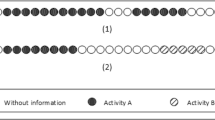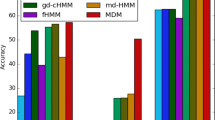Abstract
The recognition of human daily living activities within a house represents an efficient tool to model its power consumption and is also a good indicator for monitoring the health status of the inhabitants. The problematic of activities recognition in smart homes has been extensively addressed in several studies. In this paper, we present an original interactive tool developed under LabVIEW environment with a graphical user interface allowing the modeling of the daily living activities, based on a machine learning Hidden Markov Model. After an overview of the advantage for the consideration of this model in current human activities, we examine how the associated scientific problematic can find an interest and a solution by the integration of machine learning tools. Thus, the application based on a Hidden Markov model approach, is presented and evaluated using two sets of experimental data from literature. Comparing with results obtained by other daily living activities recognition methods, we point out the very satisfactory recognition performance of the Hidden Markov Model and the likelihood of our development associated to a user-friendly graphical interface. This work opens the way to applications dedicated to the supervision of human daily living activities and / or to the management of the electrical consumption within a smart home equipped with non-intrusive sensors.











Similar content being viewed by others
References
Alaa M, Zaidan AA, Zaidan BB, Talal M, Kiah MLM (2017) A review of smart home applications based on internet of things. J Netw Comput Appl 97:48–65. https://doi.org/10.1016/j.jnca.2017.08.017
Aldrich FK (2006) Smart homes: past, present and future. Insid Smart Home:17–39. https://doi.org/10.1007/1-85233-854-7_2
Bitter R, Mohiuddin T, Nawrocki M (2007) LabView advanced programming techniques. CRC Press
Brank J, Mladenić D, Grobelnik M, Liu H, Mladenić D, Flach PA, Garriga GC, Toivonen H, Toivonen H (2011) F-measure. In: Sammut C, Webb GI (eds) Encyclopedia of machine learning. Springer, Boston, pp 416–416. https://doi.org/10.1007/978-0-387-30164-8_315
Brecha RJ, Mitchell A, Hallinan K, Kissock K (2011) Prioritizing investment in residential energy efficiency and renewable energy — A case study for the U. S. Midwest. Energy Policy 39(5):2982–2992. https://doi.org/10.1016/j.enpol.2011.03.011
Chernbumroong S, Cang S, Atkins A, Hongnian Y (2013) Elderly activities recognition and classification for applications in assisted living. Expert Syst Appl 40(5):1662–1674. https://doi.org/10.1016/j.eswa.2012.09.004
Cornuéjols A, Miclet L (2002) Apprentissage Artificiel Concepts et Algorithmes. EYROLLES
Ferrández-Pastor FJ, Mora-Mora H, Sánchez-Romero JL, Nieto-Hidalgo M, García-Chamizo JM (2017) Interpreting human activity from electrical consumption data using reconfigurable hardware and hidden Markov models. J Ambient Intell Humaniz Comput 8(4):469–483. https://doi.org/10.1007/s12652-016-0431-y
Fleury A, Vacher M, Noury N (2010) SVM-based multimodal classification of activities of daily living in health smart homes: sensors, algorithms, and first experimental results. IEEE Trans Inf Technol Biomed 14:274–283. https://doi.org/10.1109/TITB.2009.2037317
Geller H, Schaeffer R, Szklo A, Tolmasquim M (2004) Policies for advancing energy efficiency and renewable energy use in Brazil. Energy Policy 32(12):1437–1450. https://doi.org/10.1016/S0301-4215(03)00122-8
Grewal JK, Krzywinski M, Altman N (2019) Markov Models — Hidden Markov Models. Nat Methods 16(9):795–796. https://doi.org/10.1038/s41592-019-0532-6
Hellgren M (2015) Energy Use as a Consequence of Everyday Life. https://doi.org/10.3384/diss.diva-122253
Hu Q, Li F (2013) Hardware Design of Smart Home Energy Management System with dynamic Price response. IEEE Trans Smart Grid 4(4):1878–1887. https://doi.org/10.1109/TSG.2013.2258181
Japkowicz N (2006) “Why question machine learning evaluation methods? (An illustrative review of the shortcomings of current methods).” AAAI-2006 Workshop on Evaluation Methods for Machine Learning, 6
Kakas AC, Cohn D, Dasgupta S, Barto AG, Carpenter GA, Grossberg S, Webb GI et al (2011) Accuracy. In: Sammut C, Webb GI (eds) Encyclopedia of machine learning. Springer, Boston, pp 9–10. https://doi.org/10.1007/978-0-387-30164-8_3
Kang J, Kim M, Park JH (2016) A reliable TTP-based infrastructure with low sensor resource consumption for the smart home multi-platform. Sensors (Switzerland) 16(7):1–15. https://doi.org/10.3390/s16071036
Karaman S, Benois-Pineau J, Dovgalecs V, Mégret R, Pinquier J, André-Obrecht R, Gaëstel Y, Dartigues JF (2014) Hierarchical hidden Markov model in detecting activities of daily living in wearable videos for studies of dementia. Multimed Tools Appl 69(3):743–771. https://doi.org/10.1007/s11042-012-1117-x
Kim MJ, Myoung Won O, Cho ME, Lee H, Kim JT (2013) A critical review of user studies on healthy smart homes. Indoor Built Environ 22(1):260–270. https://doi.org/10.1177/1420326X12469733
Li Y, Peng X, Zhou G, Zhao H (2020) SmartJump: a continuous jump detection framework on smartphones. IEEE Internet Comput 24(2):18–26. https://doi.org/10.1109/MIC.2020.2969610
Liouane Z, Lemlouma T, Roose P, Weis F, Messaoud H (2016) A Markovian-based approach for daily living activities recognition. In: SENSORNETS 2016 - Proceedings of the 5th International Confererence on Sensor Networks, 214–19. https://doi.org/10.5220/0005809502140219.
Ordóñez J, de Toledo FP, Sanchis A (2013) Activity recognition using hybrid generative/discriminative models on home environments using binary sensors. Sensors (Switzerland) 13(5):5460–5477. https://doi.org/10.3390/s130505460
Rabiner LR, Juang BH (1986) An introduction to hidden Markov models. IEEE ASSP Mag 3(1):4–16. https://doi.org/10.1109/MASSP.1986.1165342
Ricquebourg V, Menga D, Durand D, Marhic B, Delahoche L, Logé C (2006) The smart home concept: our immediate future. 2006 1st IEEE International Conference on E-Learning in Industrial Electronics, ICELIE, no. May 2014: 23–28. https://doi.org/10.1109/ICELIE.2006.347206
Sammut C, Webb GI, eds. (2010) Recall. In: Encyclopedia of Machine Learning, 829. Boston: Springer. https://doi.org/10.1007/978-0-387-30164-8_702
Shultz TR, Fahlman SE, Craw S, Andritsos P, Tsaparas P, Silva R, Drummond C, Ling CX, Sheng VS, Drummond C, Lanzi PL, Gama J, Wiegand RP, Sen P, Namata G, Bilgic M, Getoor L, He J, Jain S, Stephan F, Jain S, Stephan F, Sammut C, Harries M, Sammut C, Ting KM, Pfahringer B, Case J, Jain S, Wagstaff KL, Nijssen S, Wirth A, Ling CX, Sheng VS, Zhang X, Sammut C, Cancedda N, Renders J-M, Michelucci P, Oblinger D, Keogh E, Mueen A (2011) Confusion matrix. In: Sammut C, Webb GI (eds) Encyclopedia of machine learning. Springer, Boston, pp 209–209. https://doi.org/10.1007/978-0-387-30164-8_157
Tahir SF, Fahad LG, Kifayat K (2019) Key feature identification for recognition of activities performed by a smart-home resident. J Ambient Intell Humaniz Comput 11:2105–2115. https://doi.org/10.1007/s12652-019-01236-y
Tapia EM, Intille SS, Larson K (2004) Activity recognition in the home using simple and ubiquitous sensors. Lect Notes Comput Sci 3001:158–175. https://doi.org/10.1007/978-3-540-24646-6_10
Ting KM (2010) Precision. In: Sammut C, Webb GI (eds) Encyclopedia of Machine Learning, vol 780. Springer, Boston. https://doi.org/10.1007/978-0-387-30164-8_651
van Kasteren T, Noulas A, Englebienne G, Kröse v (2008) “Accurate activity recognition in a home setting.” UbiComp 2008 - proceedings of the 10th international conference on ubiquitous computing, 2008. https://doi.org/10.1145/1409635.1409637.
van Kasteren TML, Englebienne G, Kröse B (2010) Activity recognition using semi-Markov models on real world smart home data sets. J Ambient Intell Smart Environ 2:311–325
Van Kasteren TLM, Englebienne G, Kröse BJA (2011) Human activity recognition from wireless sensor network data: benchmark and software. Act Recognit Pervasive Intell Environ 4:165–186. https://doi.org/10.2991/978-94-91216-05-3_8
Weber S, Puddu S, Pacheco D (2017) Move it! How an electric contest motivates households to shift their load profile. Energy Econ 68:255–270. https://doi.org/10.1016/j.eneco.2017.10.010
Zhou B, Li W, Chan KW, Cao Y, Kuang Y, Liu X, Wang X (2016) Smart home energy management systems: concept, configurations, and scheduling strategies. Renew Sust Energ Rev 61:30–40. https://doi.org/10.1016/j.rser.2016.03.047
Zipperer A, Aloise-Young PA, Suryanarayanan S, Roche R, Earle L, Christensen D, Bauleo P, Zimmerle D (2013) Electric energy Management in the Smart Home: perspectives on enabling technologies and consumer behavior. Proc IEEE 101(11):2397–2408. https://doi.org/10.1109/JPROC.2013.2270172
Author information
Authors and Affiliations
Corresponding author
Additional information
Publisher’s note
Springer Nature remains neutral with regard to jurisdictional claims in published maps and institutional affiliations.
Rights and permissions
About this article
Cite this article
Guenounou, A., Aillerie, M., Mahrane, A. et al. Human home daily living activities recognition based on a LabVIEW implemented hidden Markov model. Multimed Tools Appl 80, 24419–24435 (2021). https://doi.org/10.1007/s11042-021-10814-2
Received:
Revised:
Accepted:
Published:
Issue Date:
DOI: https://doi.org/10.1007/s11042-021-10814-2




